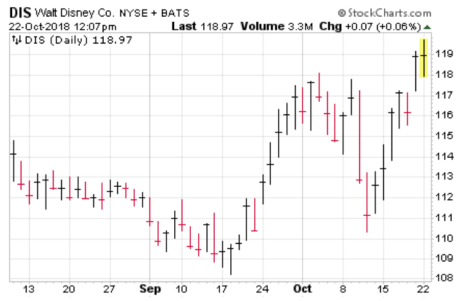There are a lot of ways to determine the stock market’s health. In our mind, the quickest way to do it is via Cabot’s Two-Second Indicator. To use it, all you have to do is find (in your newspaper or online) the number of stocks on the NYSE that hit new 52-week price lows on the previous day. If the number exceeds 40, as it has repeatedly in recent days, the market is in trouble. On the flip side, in fact, only eight stocks are at their 52-week highs. And one of them is Walt Disney stock.
Walt Disney Stock Bucking the Market Correction
What?! How has Disney (DIS) managed to zig while the rest of the market has zagged? After all, the company missed on fiscal third-quarter earnings back in August, sending shares tumbling 6% in the ensuing month.
However, since the market started to sour in mid-September, Disney stock has been on a roll, recovering all its post-August-earnings losses and then some. Just look at the chart below.
What triggered the move? Analysts are more optimistic about the recent quarter, which helps; the company is expected to grow earnings by 24% and sales by 7.4%. But that earnings report isn’t due out for another couple weeks, in early November.
No, I think this is more about streaming content. As you’ve probably heard, Disney is officially entering the streaming fray after agreeing to acquire most of Twenty-First Century Fox (FOX) in July, a deal that will take effect early next year. The $71.3 billion buyout means that Fox’s illustrious movie studio—which has produced classics such as Titanic, The Sound of Music, Avatar, Alien and the original Star Wars film—is now property of Disney.
Combined with its own film studio, which owns the Pixar, Lucasfilm (i.e. new Star Wars movies) and Marvel brands, Disney and Fox are now a movie-industry behemoth; through July, the two studios had accounted for 46% of the total box office this year.
On top of that, Disney is getting Fox’s 30% stake in Hulu, an increasingly popular streaming service.
Prior to the Fox deal, streaming was a weak spot for Disney. Its television properties, namely ESPN, have been losing customers by the millions as cord-cutters said goodbye to cable and hello to the cheaper, a-la-carte appeal of streaming services like Hulu, Netflix (NFLX) and Amazon Video.
Now, Disney suddenly has three streaming services either in the works or already launched: ESPN+, a service that allows people to stream live sports on ESPN apps and websites without having to shell out a couple hundred bucks a month for cable—it was launched six months ago and already has more than one million subscribers; a Disney-branded streaming service, due out in late 2019, that will include Disney, Pixar, Marvel and Star Wars content, plus Fox’s National Geographic library; and Hulu, which already exists, but won’t benefit Disney until its majority stake in the property takes effect early next year.
With all that in the works—and the early returns on ESPN+ looking quite strong—a year from now Disney’s weak spot may start to look like a strength. A name like Disney breaking into an industry as fast-growing as streaming seems like a can’t-miss. And Wall Street is snatching up Walt Disney stock accordingly, in anticipation of the eventual growth.
DIS vs. NFLX
It’s interesting to note that in the three months since Disney closed the Fox deal, NFLX stock is down 9%. Chances are, that’s more a market correction in Netflix stock after shares more than doubled in the first half of the year. But the looming specter of increased competition from Mickey Mouse may also be playing a role in preventing much NFLX buying.
Long term, I still think NFLX is the better stock. But Disney stock looks like a much more viable alternative now than it did at the start of the year, and streaming is a Reason #1 as to why.

Sign up now!

Sign up now!

Sign up now!

Sign up now!
